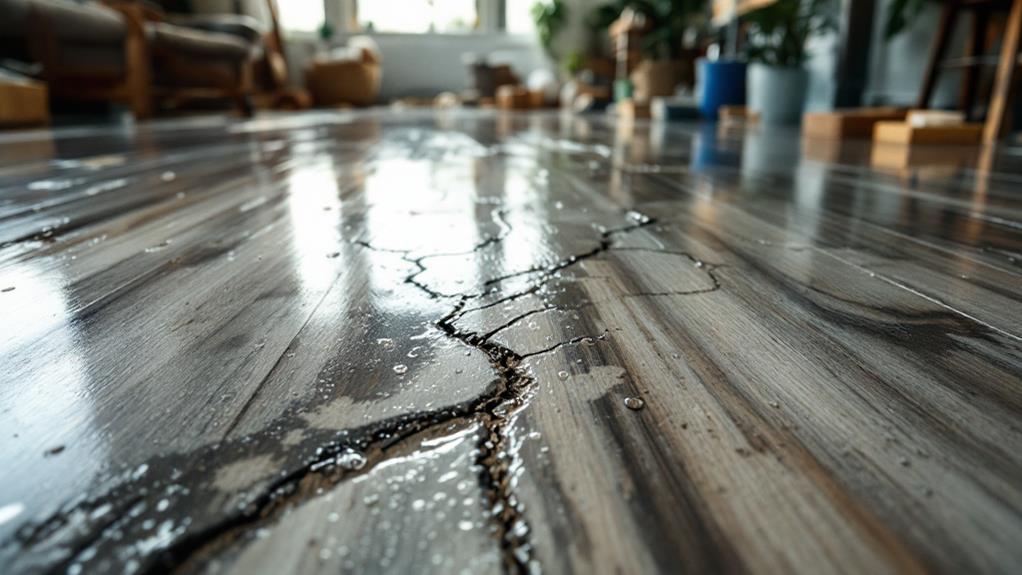Luxury vinyl plank flooring is vulnerable to water damage, which can result in expensive repairs, replacement, and even health hazards if not addressed. Warning signs of water damage include discoloration, seams opening, bubbles, and ridges on the floor, as well as mold and mildew growth. Inadequately treated concrete slabs, lack of moisture testing, and subpar installation practices can lead to water damage. By understanding these causes and implementing preventive measures, such as conducting comprehensive moisture testing and utilizing effective waterproofing solutions, homeowners can reduce the risk of water damage. Further investigation reveals the significance of proper installation and maintenance practices to safeguard the longevity of luxury vinyl plank flooring.
Key Takeaways
Water Damage Warning Signs
The presence of water damaged vinyl plank flooring can be detected through various visual indicators. Signs such as discoloration of the floor, opening of the seams, and bubbles, bumps, and ridges on the floor are all symptoms of water damage. Additionally, mold, mildew, and curling and peaking of tiles may also indicate water damage. It is essential to address these issues promptly to prevent further damage, especially since the causes of water damage can range from wet concrete slabs to plumbing errors.
Regular maintenance tips, such as cleaning up spills immediately and ensuring proper ventilation, can help prevent water damage. In cases where damage has already occurred, repair options may include removing and replacing damaged planks or, in severe cases, hiring a professional for repair.
Causes of Water Damage Revealed

When improperly treated concrete slabs or ignored groundwater seepage create a favorable environment for water damage, the outcomes can be devastating for luxury vinyl plank flooring. Proper waterproofing methods, such as using liquid membranes during installation, can help minimize these risks.
- Improperly treated concrete slabs can result in water seepage and harm to the flooring.
- Failing to conduct moisture testing on the concrete base can lead to concealed water damage.
- Overlooking groundwater seepage before installation can result in the flooring lifting or bubbling.
- Substandard installation practices, like disregarding the manufacturer’s instructions, can also contribute to water damage.
Moisture testing and correct installation are essential to preventing water damage in luxury vinyl plank flooring. By comprehending the causes of water damage, homeowners can take measures to reduce the risk and guarantee a durable, attractive floor.
Prevention Is the Best Defense
Luxury vinyl plank flooring’s susceptibility to water damage highlights the importance of proactive prevention measures. To reduce the risks, it is vital to conduct thorough moisture testing on concrete substrates before installation. This guarantees that the flooring is placed on a dry and stable surface.
In addition, using effective waterproofing solutions like Hydro Ban can boost protection against water damage. Moreover, following manufacturer-provided installation tips and guidelines can help prevent water damage. This involves adhering to strict protocols for acclimating the flooring to the installation environment, ensuring proper sealing and caulking, and maintaining a clean and dry installation site.
Treating Water Damaged Flooring

One prominent concern with water-damaged luxury vinyl plank flooring is the potential for hidden damage, which can lead to extensive repair or even replacement of the flooring. When treating water-damaged flooring, it is essential to prioritize moisture management and damage restoration.
- Ventilate the crawlspace for several days to remove excess moisture.
- Address specific sources of moisture, such as leaks or flooding, to prevent further damage.
- Remove flooring from a concrete subfloor to allow for thorough drying.
- Use a heater and fan in the room for drying, and consider hiring installation experts for severe damage.
Myths and Truths About Vinyl Plank

Debunking misconceptions about vinyl plank flooring is essential for informed decision-making. Many homeowners are unsure about the benefits and limitations of this popular flooring option. Understanding the myths and truths about vinyl plank flooring can help homeowners make informed decisions.
| Myth | Truth | Benefits |
|---|---|---|
| Vinyl plank is not durable | Vinyl plank is highly resistant to wear and tear | Long-lasting flooring solution |
| Vinyl plank is not eco-friendly | Many vinyl plank brands offer eco-friendly options | Environmentally responsible choice |
| Vinyl plank is only for low-traffic areas | Vinyl plank can withstand heavy foot traffic | Suitable for high-traffic areas |
Understanding the benefits and misconceptions about vinyl plank flooring can help homeowners make informed decisions. By recognizing the myths and truths, homeowners can enjoy the benefits of vinyl plank flooring, including its durability, eco-friendliness, and suitability for high-traffic areas.
Frequently Asked Questions
When installing vinyl plank flooring over radiant heating systems, confirm compatibility by adhering to manufacturer’s installation requirements, as temperature fluctuations can affect the flooring’s performance and longevity, and consider using a thermal barrier to maintain ideal temperatures.
Conclusion
In conclusion, water damage to Luxury Vinyl Plank flooring is an important concern that requires attention to prevention and treatment. Understanding the warning signs, causes, and prevention methods is essential to maintaining a long-lasting and luxurious flooring experience. By acknowledging the vulnerabilities of LVP flooring, homeowners and designers can take proactive steps to mitigate water damage, ensuring a durable and stylish flooring solution.







